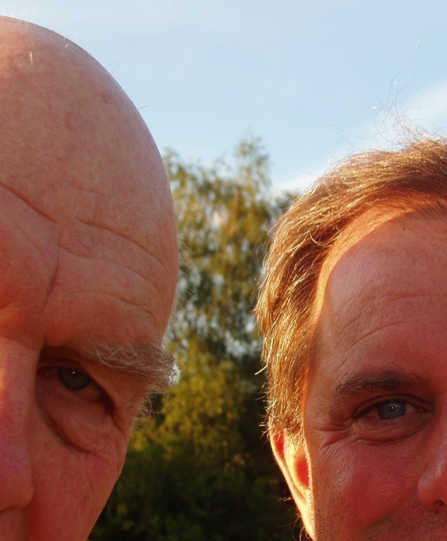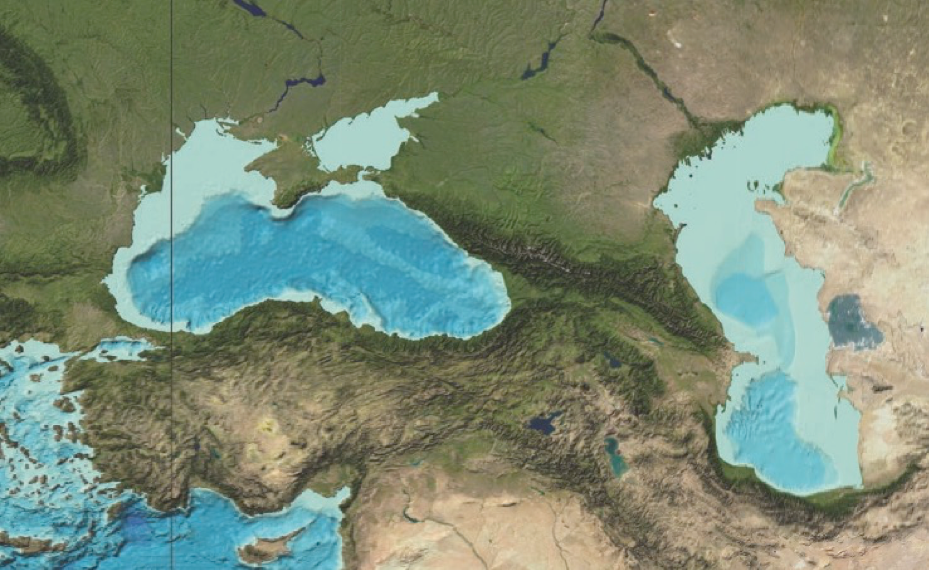“Under the influence” of Walter
The first three words I ever heard Walter Pitman say were all the same and cannot be written here, but began with “F”.
He was two hours late for a work session at SUNY Albany with John Dewey and I, then a first-year MS student helping the two of them with a study of the Hercynian-Alleghanian Orogeny as Gondwana collided with Laurentia. It was a blizzardy day in February 1980, and Walter had had a flat tire on I-87 that he replaced (himself) in blinding snow. His eloquence upon arrival in John’s office was matched by the spectre of a man dripping wet in a bulbous navy goose down ribbed parka, wrinkled beige chinos (in winter), navy wool hat (which we ALL know) with a small hole in it, and one boot untied (or perhaps, one boot tied). John then proceeded to introduce me to the great Walter Pitman whose name I had known for 4 years by then, an event for which I had been sure that morning to dress rather smartly.
OK, reboot all Great Expectations… The three of us then proceeded to make a synthesis of the Alleghanian that might still stand to this day. John knew the continental-scale structural trends he needed to satisfy. Walter had done the Devonian-Permian paleomagnetics for the two continents. And I had altered the presumed shape of northern Gondwana by tightening the Equatorial Atlantic relative to Bullard’s fit by some 400 km, and by reconstructing the blocks of the northern Andes. I had also determined that the LePichon and Fox fit for the Central Atlantic was the best one to use for the final closure (and it still is, today).
What I saw happen that day was mind-blowing and reaffirmed my sense as a budding geologist that “continental plate tectonics is for me”. For each time interval Devonian-Mississippian-Pennsylvanian-Permian, John taped down a big map of North America on his enormous light table, and Walter moved Eüler printouts of our depiction of Gondwana along paleo-latitudinal lines, until John yelled “STOP” and began tracing vigorously with his pencil (who needs a computer to evolve the planet?). Although I couldn’t see it at the time, the result became a smoothly diachronous oblique collision guided by continental shear zones from the British Isles to Mexico that spanned 100 m.y. Not to dwell on them, cartoons and brief descriptions of these hemispheric reconstructions adorned only two pages of John’s seminal 1982 William Smith paper that focussed otherwise on how sedimentary basins work.
I was to learn over the next several years that my first 30 seconds with “Professor Walter C. Pitman III” exemplified precisely the real Walter who we all loved so much. Walter kindly let me stay with him for the months I spent at Lamont working on the Atlantic opening with the new GeoSat data, and I am proud to be able to say that Walter in many ways came to fill the shoes of my own father, who died just a few years later and before I finished my PhD with John. Further down the road, Walter and his daughter Amanda visited and skied with Alison and I in New Hampshire, he came to Barbados with us a couple of times for holidays, and he spent a number of weeks with us in England, visits he referred to as “loitering with the Pindells”. He never understood why anyone in their right mind would drink warm, flat beer.
For many years, Walter, John, Steve Cande and I continued to put our heads together (see Photo 1) on several things, such as the Andes. And with John LaBrecque, Bill Haxby and David Rowley, we rolled out the Late Cretaceous to Present Caribbean story from my thesis in 1988, which pretty much holds to this day. The foundation for that model had more to do with the Atlantic plate motions over the mantle than with all the messy Caribbean geology, and, for me at least, Walter had made the Atlantic approach possible.

In later years, I often listened with wonder about Bill Ryan’s and Walter’s flood story. I read two or three versions of Gilgamesh, and as a geologist I was always bothered by the repeated references in all of them to “pitch” and “bitumen”. It reads: “Uta-napishti (Noah) sent the boys to collect pitch, and they returned with so much that he was able to caulk the inside of the ark as well as the outside, and he sent the extra home with the fishermen”, or thereabouts depending on the version. I didn’t think the Black Sea had any such pitch deposits, so the sources of bitumen either lie below the water today (i.e., they were flooded) and remain undiscovered (unlikely?), or, perhaps, the story had a slightly different setting. So, in his final year I tried to get Walter to contemplate the Caspian Sea which has plentiful pitch at Baku. I also always wanted to visit and discuss this idea with Bill during one of my visits to New York, but it just never happened. Maybe it still can.
Over wine during two or three visits, we entertained the following. The linear Caucasus Mountain chain separates two potential pathways for Black Sea water to enter the Caspian. Both of these today have less than 15 m elevation at their highest points, and much of the two pathways remain below sea level (Google Earth). The northern path has curious WNW linear rills that could be water related, but perhaps are wind related. The southern path, the Georgia-Azerbaijan channel, has active sedimentation and apparently is also rising (see Photo 2). We know from the salt in the Caspian that sea water did indeed cross at least one of these paths, and apparently many times in the past. If the depositional surface of one of these paths was similar to the depth of the Bosporus channel when it was breached 7400 years ago, then the game is on. A shallowing of the depositional surface of about 30 meters (average of 4 mm/yr), combining sedimentation and tectonic uplift, may be enough to explain today’s subaerial separation. In the case of the southern path, the area of elevation would need to center on Georgia. Perhaps the “great noise” of the flood was the unconstrained flow of water like a tsunami over the Azerbaijan floodplain down into the Caspian Depression, which today is again below sea level. As Gilgamesh says, “The world was turned to clay”.

This scenario implies two floods: the first to fill the Black, and a second to spill into the Caspian once the Black was nearly filled. But they might have occurred only weeks or months apart. And maybe the gods “knew what was coming” (Gilgamesh) because it had already happened before at the Bosporus, and was perhaps relayed to them via the telegraph of the day. And who were the gods? These beings who “came down from heaven” to the earth, and who happily accepted lamb feasts, and who often produced “demi-god” offspring with “mortals” (the mortals were almost always the mothers, surprise-surprise), and who were allowed to maintain relatively special status in the eyes of both the gods and the mortals? And who “were frightened so badly by the noise and the havoc of what they had inflicted that they climbed to the highest peak, where they cowered like dogs against the rocks until it was over”. Were they the bosses of the earthlings (slaves?), who happened to live in the eastern Caucasus Mountains, high above the worst of the heat and looking out over the plains of the “earth”, below sea level before the flood, with Baku in the hazy distance?
And after the deluge, when Gilgamesh returned and travelled with the Boatman over the “fetid waters of death” to find Uta-napishti the Distant (now the immortal Noah), did they have to pole past Baku, with the water level now closer to global sea level, with all its seeping methane gas and hydrogen sulphide, on their way up the northwest Caspian? Why did the Boatman live alone on an island, such that Gilgamesh had to use a raft to reach him before their journey together began? Had the rise in water level isolated the Boatman from the rest of the local world already? Had he necessarily become a boatman because of the flood, his house now isolated on its own? Was the “subsiding” of the flood caused by evaporation of water, along with infiltration into the former coastal plains, in a land-locked sea? A “subsiding” of the flood could only happen in the Caspian, and not in the Black, assuming the Bosporus remained open to the Mediterranean…
Back to the Atlantic, and to the Gulf of Mexico and Caribbean... Today, some 35 years since my student days with Walter and John, I am placing an animation of the break-up of western Pangea on this website in Walter’s memory, prepared with Diego Villagomez at the University of Geneva, which Walter and John had set in motion so long ago. The animation summarises the model in Pindell et al. (2020, Geol. Soc. London SP 504), and I am tempted to say that this story I started with John, Walter and Steve Cande is finally “done enough”, hopefully the 90% solution. Walter once referred to such geological syntheses as : “A guy visits an auto repair center (a university), picks through hundreds of thousands of bits and pieces of junk in the field out back (the data and literature), selects, hammers, drills, bolts, rivets, paints and polishes (researches), and builds a flashy Cadillac that purrs like a cat (the thesis)”.
Well, the interesting thing about this animation is that, over time, the story has become progressively simpler and simpler. This is not because we ignore details as we get older. It is because the literature is fraught with misunderstanding and misinterpretation, and as students, we try to incorporate everything we can. But many years later, it becomes clear that much of what we tried to integrate is either wrong or misleading, and has tainted the thesis. Plate tectonics should be simple at a big scale, even predictable, and the evolution to simpler interpretations comes when we finally figure out which “information” should be discarded. Walter was always very sympathetic to this dilemma of studentship, and today the problem has become far worse because the “scrap yard of bits and pieces of junk” in many disciplines has become as large as the State of Texas. And yet, we still expect students to defend in 3 or 4 years. Walter once joked that a person was ready to defend not when they knew enough, but when they had learnt enough to know what can be discarded. This was pure and honest Walter, who also liked to say that “too much data gets in the way of good thinking”.
Surely celebrating Walter’s amazing past is the best tonic for the mourning of his passing. No doubt Cordelia and Amanda recognize what an outstanding man their father was, and carry deep pride in being his daughters. Unfortunately, we Walter’s colleagues have been prevented from celebrating Walter’s friendship, tuition and achievements together. Hopefully, this website will go a long way toward that end.
J. Pindell
3 June 2020, West Sussex
